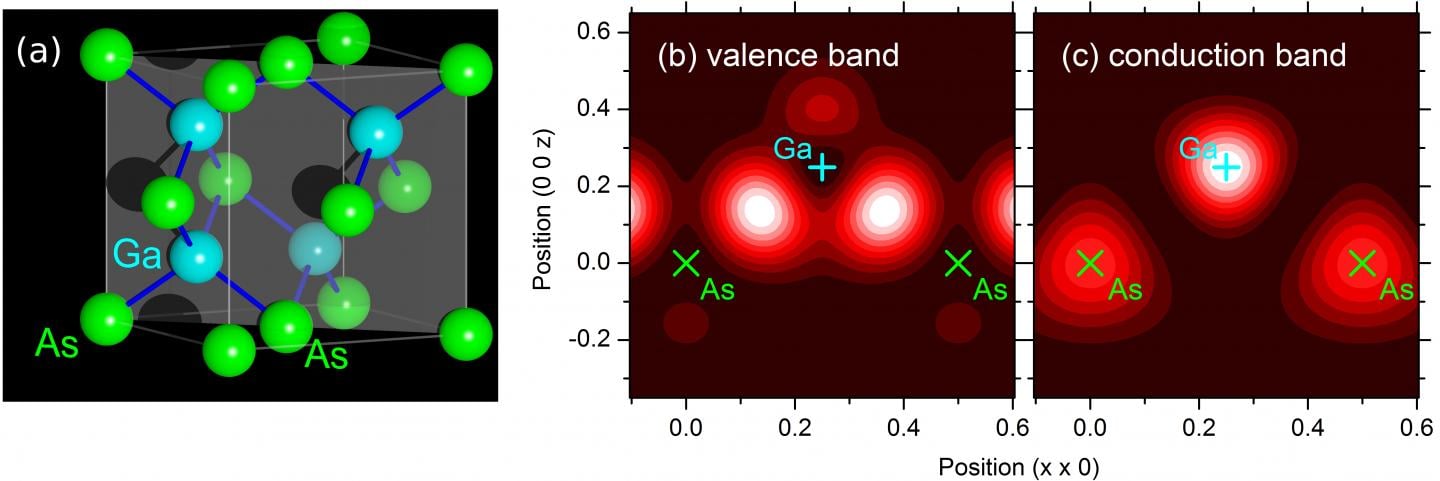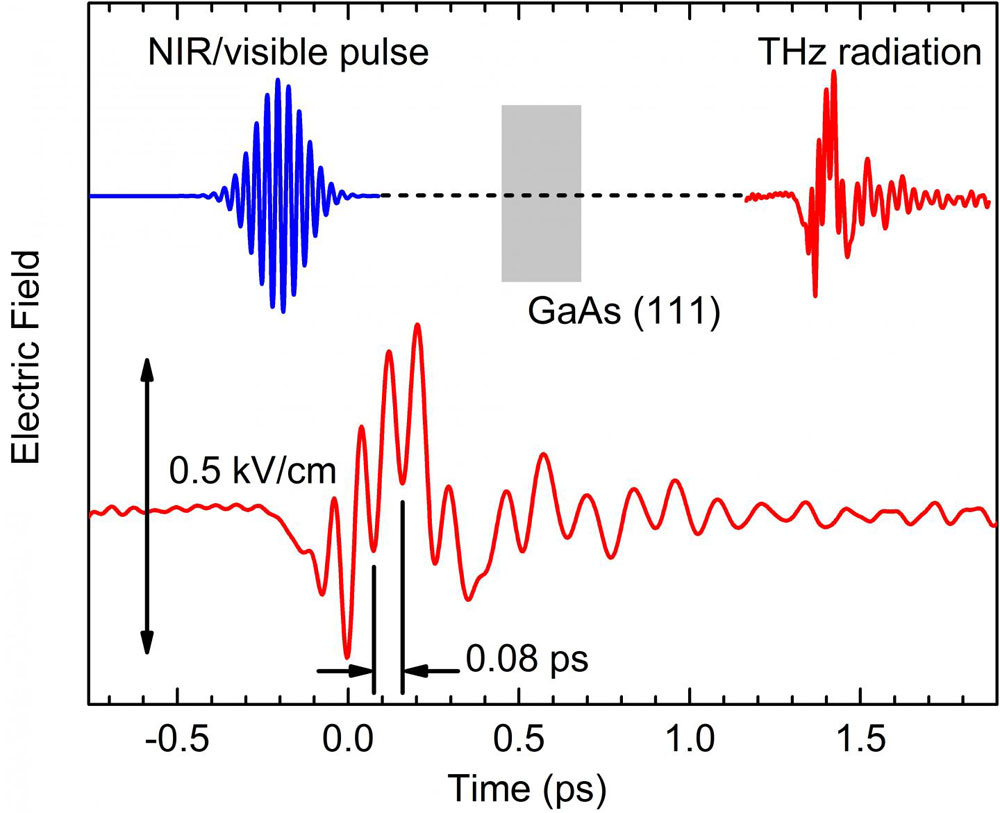 (a) Unit cell of the semiconductor gallium arsenide (GaAs). Chemical bonds (blue) connect every Ga atom to four neighboring As atoms and vice versa. Valence electron density in the gray plane of (a) in the (b) ground state (the electrons are in the valence band) and in the (c) excited state (electrons are in the conduction band). Apart from the valence electrons shown, there are tightly bound electrons near the nuclei. Courtesy of MBI Berlin.
The research considered three questions pertaining to the conversion of light to electricity: What is the smallest unit in a crystal that can provide a photo-induced direct current? What is the maximum frequency at which a current can be generated? Which mechanisms at the atomic scale are responsible for charge transport at high frequencies?
(a) Unit cell of the semiconductor gallium arsenide (GaAs). Chemical bonds (blue) connect every Ga atom to four neighboring As atoms and vice versa. Valence electron density in the gray plane of (a) in the (b) ground state (the electrons are in the valence band) and in the (c) excited state (electrons are in the conduction band). Apart from the valence electrons shown, there are tightly bound electrons near the nuclei. Courtesy of MBI Berlin.
The research considered three questions pertaining to the conversion of light to electricity: What is the smallest unit in a crystal that can provide a photo-induced direct current? What is the maximum frequency at which a current can be generated? Which mechanisms at the atomic scale are responsible for charge transport at high frequencies?
The team investigated optically induced shift currents in the semiconductor gallium arsenide (GaAs) at ultrafast timescales of down to 50 femtoseconds (fs). Using ultrashort, intense light pulses from the NIR to the visible range, the researchers generated shift currents in the GaAs that oscillated, emitting radiation with a bandwidth up to 20 THz.
The properties of these currents and the underlying electron motions were fully reflected in the emitted THz waves that were detected in amplitude and phase. The THz radiation showed that the ultrashort current bursts of rectified light contained frequencies that were 5000 times higher than the highest clock rate of modern computer technology.
 The experimental concept is shown at the top. A short pulse in the NIR or visible spectral range is sent onto a thin GaAs layer. The electric field of the emitted THz radiation is measured as a function of time (1 ps = 10 to the power of −12 s). An example of such a THz waveform is shown in the bottom portion of the image. It contains oscillations with a period of 0.08 ps corresponding to a frequency of 12,000 GHz = 12 THz. Courtesy of MBI Berlin.
In the the smallest unit of a crystal, the unit cell, of the researchers’ prototype of a GaAs semiconductor, the Ga and As atoms were arranged without a center of inversion. In the ground state of the crystal, the valence electrons were concentrated on the bonds between the Ga and the As atoms. When an electron absorbed NIR or visible light, it moved from the valence band to the next higher band, namely the conduction band.
In its new state, the electron charge shifted toward the Ga atoms. This charge transfer corresponded to a local electric current, the interband or shift current, which is different from the electron motions in intraband currents. The researchers said that there has been a debate among scientists as to whether experimentally observed photo-induced currents are due to intraband or interband motions.
The experimental concept is shown at the top. A short pulse in the NIR or visible spectral range is sent onto a thin GaAs layer. The electric field of the emitted THz radiation is measured as a function of time (1 ps = 10 to the power of −12 s). An example of such a THz waveform is shown in the bottom portion of the image. It contains oscillations with a period of 0.08 ps corresponding to a frequency of 12,000 GHz = 12 THz. Courtesy of MBI Berlin.
In the the smallest unit of a crystal, the unit cell, of the researchers’ prototype of a GaAs semiconductor, the Ga and As atoms were arranged without a center of inversion. In the ground state of the crystal, the valence electrons were concentrated on the bonds between the Ga and the As atoms. When an electron absorbed NIR or visible light, it moved from the valence band to the next higher band, namely the conduction band.
In its new state, the electron charge shifted toward the Ga atoms. This charge transfer corresponded to a local electric current, the interband or shift current, which is different from the electron motions in intraband currents. The researchers said that there has been a debate among scientists as to whether experimentally observed photo-induced currents are due to intraband or interband motions.
The MBI researchers said that the properties of the observed shift currents that resulted in the THz wavelengths excluded any intraband motion of electrons or holes. In contrast, the team was able to reproduce its experimental results with model calculations based on the interband transfer of electrons in a pseudo-potential band structure, and show that a real-space transfer of electrons over the distance on the order of a bond length was the key mechanism. This process was operative within each unit cell of the crystal, that is, on a subnanometer length scale, and caused the rectification of the optical field. The researchers believe that this effect could be exploited at even higher frequencies, offering potential new applications in high-frequency electronics.
The research was published in Physical Review Letters (https://doi.org/10.1103/PhysRevLett.121.266602).

